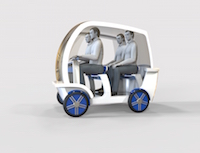You are hereSmart e-vehicles for a smarter mobility
Smart e-vehicles for a smarter mobility
A few possible scenario’s to recover our mobility in the city.
 Mobility and communication are two essential mechanisms for social interaction. They also determine how efficient economies can operate. This is why people often tend to live and work in cities or locate their activities in close proximity as it shortens the interaction distance. Communication has seen a revolutionary evolution in the last decades. We are now virtually reachable anywhere, any time of the day and sharing information is a click away. There is so much data being generated and available that we need smart applications to filter the essence from the noise.
Mobility and communication are two essential mechanisms for social interaction. They also determine how efficient economies can operate. This is why people often tend to live and work in cities or locate their activities in close proximity as it shortens the interaction distance. Communication has seen a revolutionary evolution in the last decades. We are now virtually reachable anywhere, any time of the day and sharing information is a click away. There is so much data being generated and available that we need smart applications to filter the essence from the noise.
 While internet and high bandwidth have brought down the cost of communicating to a very low marginal cost, the same cannot be said about our cost of moving. Of course, this is not a universal statement. Long distance travel, using airplanes and ships is more efficient and safe than ever. Even cars have become relatively cheap if one takes into account the comfort they now provide. What is hampering the economy is the mobility at city level. Unless we move out of the cities again, what is unlikely to happen as cities are spreading from the suburbs, we need to find solutions to give us again the mobility we need. Even with all avatars in the world humans need face-to-face interaction.
While internet and high bandwidth have brought down the cost of communicating to a very low marginal cost, the same cannot be said about our cost of moving. Of course, this is not a universal statement. Long distance travel, using airplanes and ships is more efficient and safe than ever. Even cars have become relatively cheap if one takes into account the comfort they now provide. What is hampering the economy is the mobility at city level. Unless we move out of the cities again, what is unlikely to happen as cities are spreading from the suburbs, we need to find solutions to give us again the mobility we need. Even with all avatars in the world humans need face-to-face interaction.
While the situation is different from country to country, we’ll take a typical situation as a starting point. Consider the morning of 20th January 2015 in Brussels. A single defective truck (there was not even an accident) resulted in hours and tens of kilometer long traffic jams. This simple incident is common but illustrates very well the more fundamental issues. Traffic is dense, but not dense enough in terms of making use of the space as a resource. This includes the space in the vehicles and the space taken by the vehicles on the road especially at an acceptable high enough average speed. We should consider traffic like a telecommunication system using packet switching. Not only is the bandwidth important but also the capacity of the junction points. This applies to any type of transport and mobility mechanism we use, even more so when we mix them. How can we transform our mobility networks to look more like a high capacity communication network?
Consider now January 2020. Two things have happened. We firstly have removed as many bottlenecks as we could. Junction points were redesigned to handle twice the capacity of the connecting roads. Traffic lights were eliminated by building roundabouts or replaced with under- or overpasses or four-way stops to minimise the time traffic is waiting to move. While these were improvements at infrastructure level, the congestion was tackled by ride and cost sharing. Heavily promoted as a public service, it is used on a daily basis. People post their mobility needs and offers via a smartphone Global Mobility App to a server, who constantly matches them and calculates the shortest route in real-time. The results are dramatic, resulting in a traffic reduction with 30 upto 50% with the average vehicle occupation increasing from 1,3 to 3 persons/vehicle. At the end of the month, all registered users receive an account statement. People providing rides receive a portion of their costs back. People who ride along, make a net contribution to the cost. The result is less traffic jams, less pollution and a more efficient use of roads and vehicles. While this solution works well for people owning a car, a gradual mentality shift has occurred as well. Car ownership is no longer a must. The convenience and cost benefits have opened a new class of electric vehicles that are highly standardised yet very comfortable and equipped with a learning intelligence enhanced by the information gathered on the ride and cost sharing servers.
Something else has happened as well. After one year of use, taxis and public transport means were added to the offer. Pre-condition was that the service was offered at the real costprice (no subsidies, no profit margin). Taxi pricing dropped significantly, but some people were now willing to pay extra for the driver’s service offered as well as for the luxuries on board. The same happened with public transport. Only high capacity transport connections could remain in service, and only because the comfort and service on board was brought up to an attractive level. Mass transport received a new meaning.
In 2022, years of testing autonomous vehicles has paved the way to a widespread legalization. While on longer distance roads, a driver must still be attentive at the steering wheel, in the cities non-electric vehicles had already gradually been banned and replaced by a fleet of smaller electric vehicles to tackle air, noise and heat pollution. In 2022, they became fully autonomous and callable using the Global Mobility App. As predicted in 2015 by a ground breaking study from the International Transport Forum, there are now 90% less vehicle on the city streets, three times less space needed for parking while people’s mobility had in in increased with 30%, partly absorbed by newer higher quality underground metro lines.
Now we move fast forward to 2025. Over the last years, transport of goods has been automated. Using a similar scheme like the ride and cost sharing, modular containers now move around using automated vehicle platforms. They have been put on dedicated road sections, part of them recovered from unused train tracks. The same evolution is now replacing mass transport of people. Scalable automated vehicles move people on demand. While some people still have their own vehicles, most often they rent transport time from a mobility-pod provider, even changing to smaller vehicles when entering city limits. Automated traffic however does not mean that the driver is no longer capable of steering the vehicle. However, the artificial intelligence algorithms learn from the driver’s behaviour and gradually it can take over on known routes. Most often, the mobility pods drive in platoon anyway, resulting in a shift away from trains and busses. Paradoxically, train and bus companies were the first to bring the mobility pods to the market. For them, this is just the new way of providing mass transportation.
Will this scenario happen? Maybe it will not happen as fast as investments need to be written off. But it shows a roadmap. It also shows that we can already achieve a lot without major investments if the problem is well understood. Smart mobility is one of the essential ingredients for the economy to prosper. To quote Jack Welch, ex-CEO GE “If the rate of change on the outside is greater than the rate of change on the inside, the end is near”. In other words, standing still is not an option, moving forward is a must.
An adapted version of this article appeared on Move Forward.
- Printer-friendly version
- Login to post comments